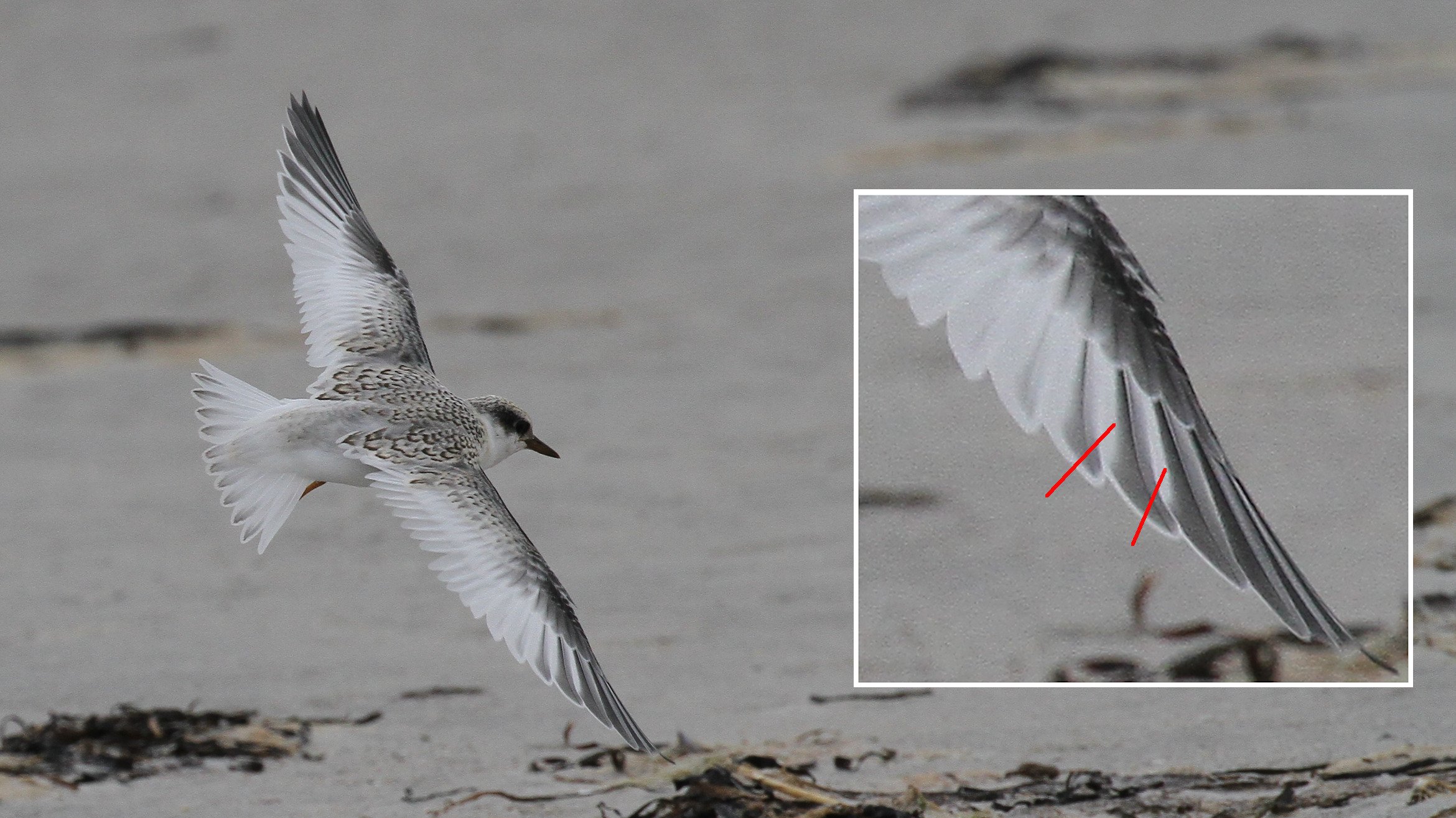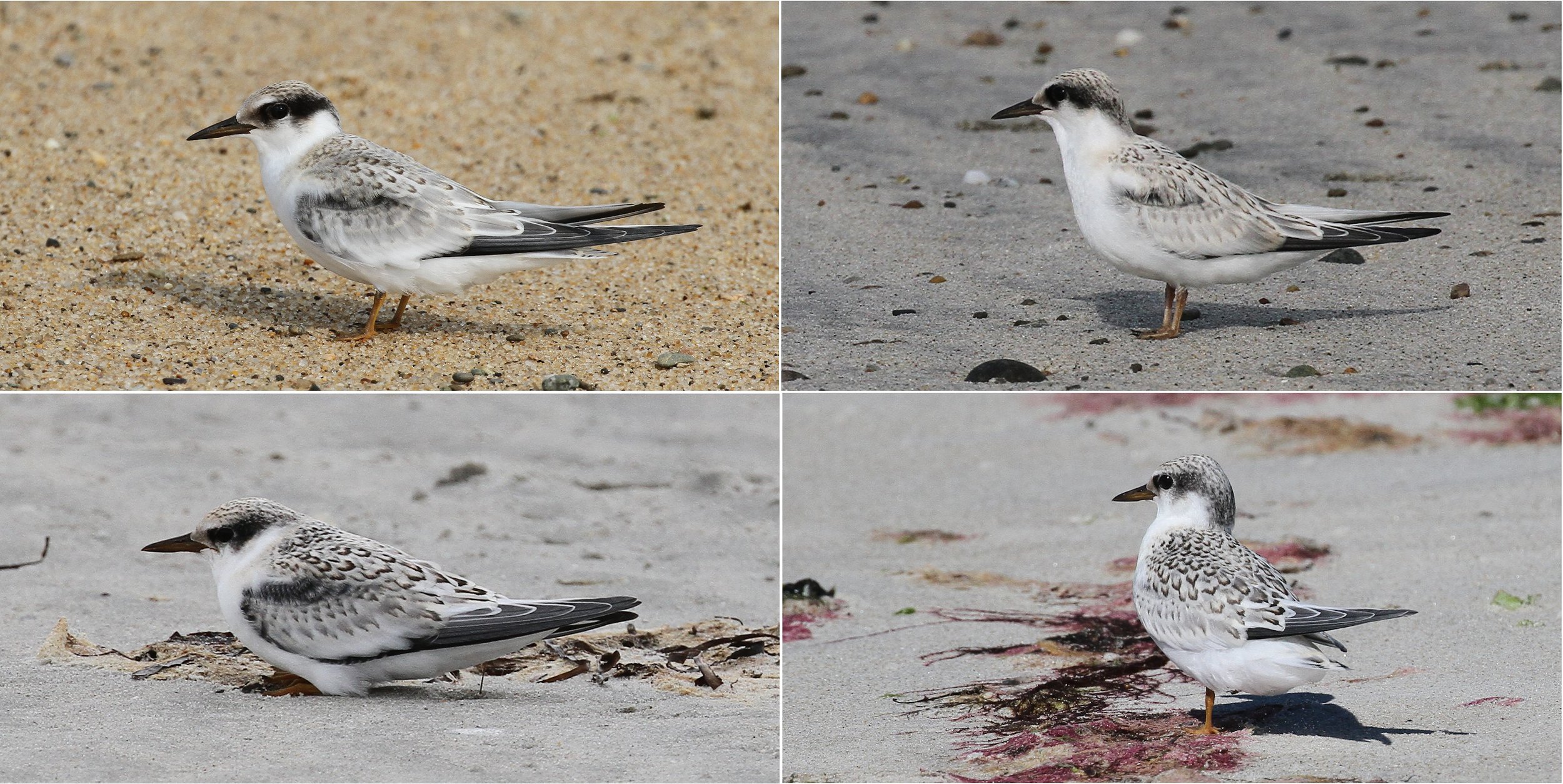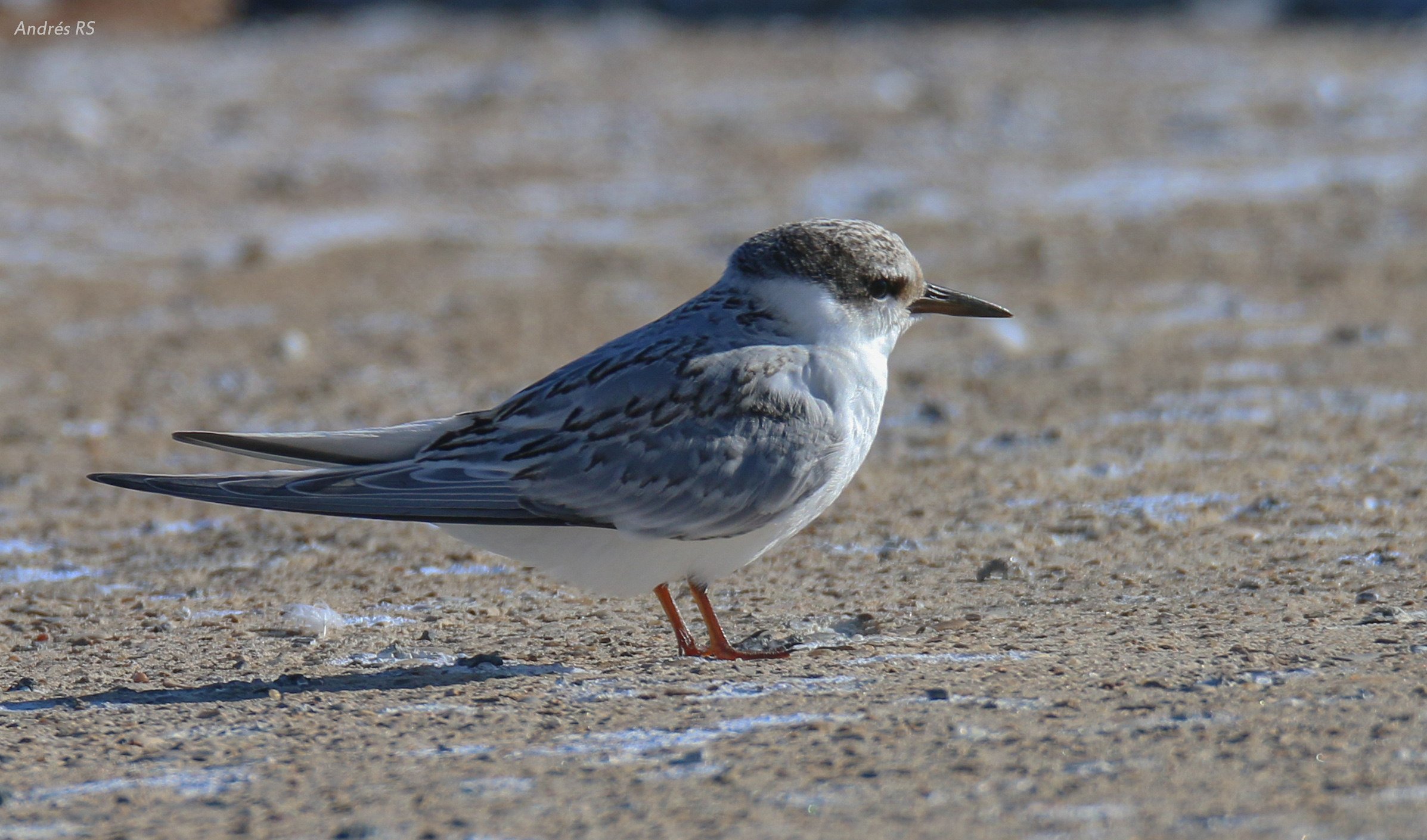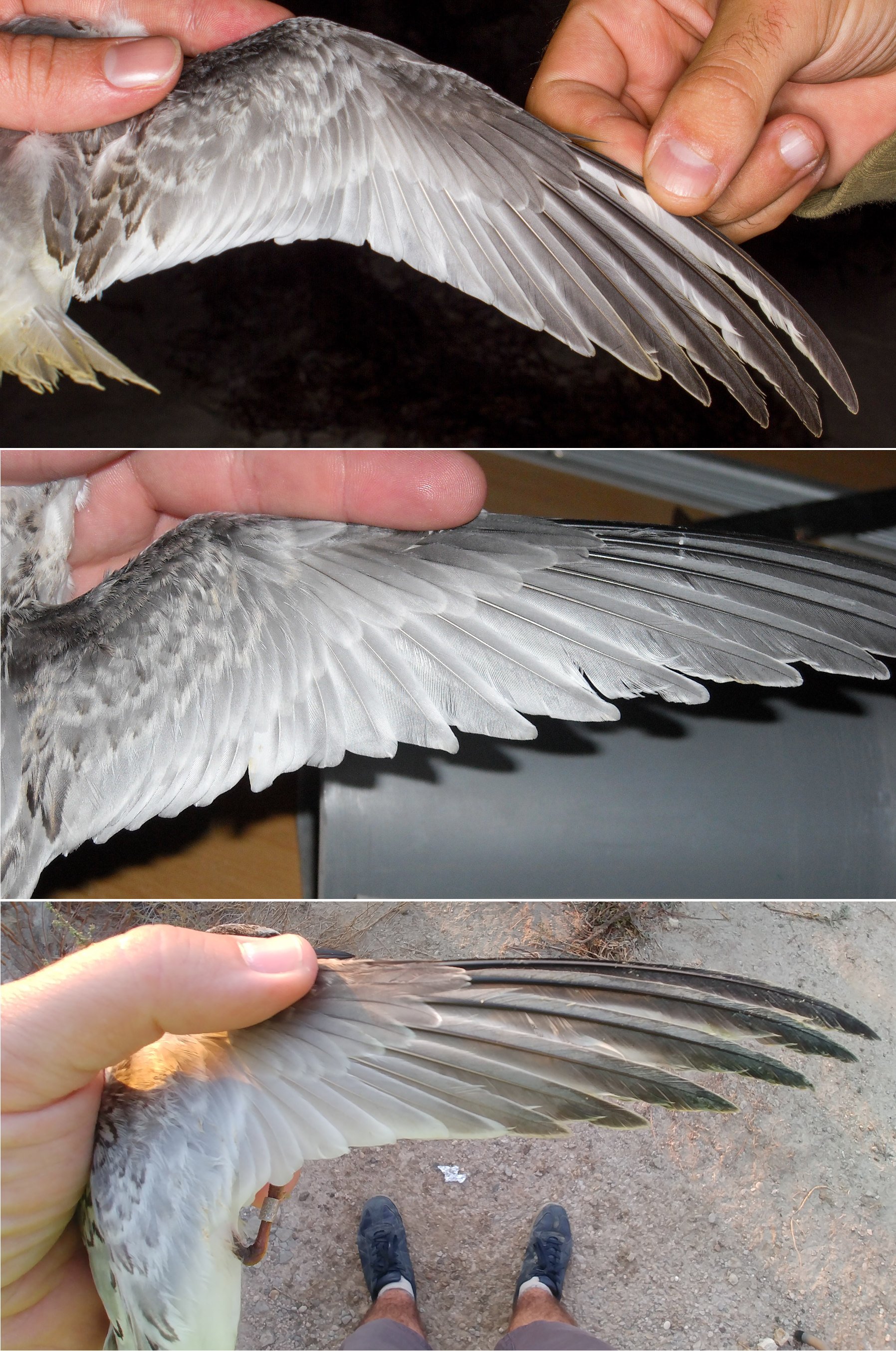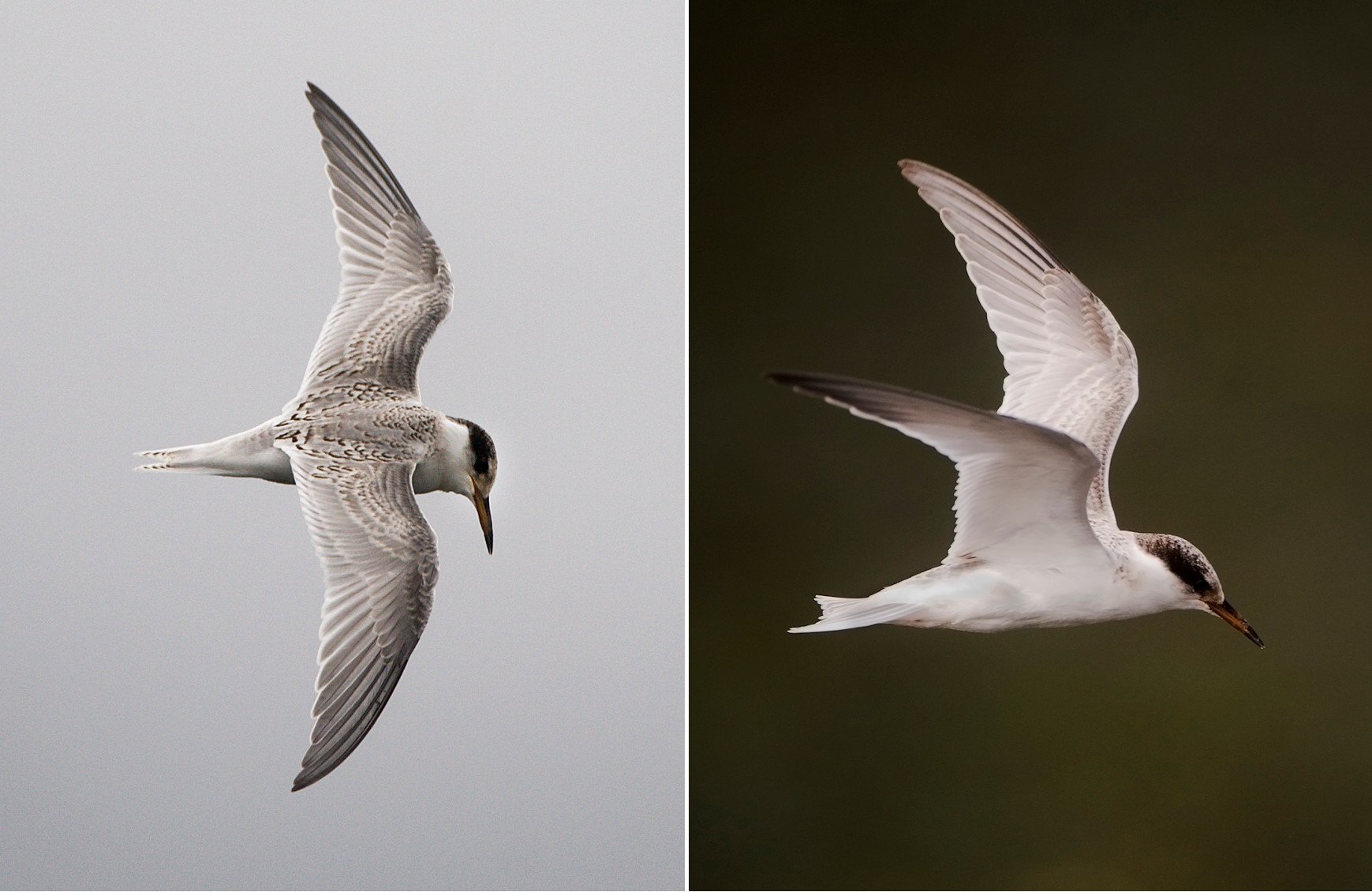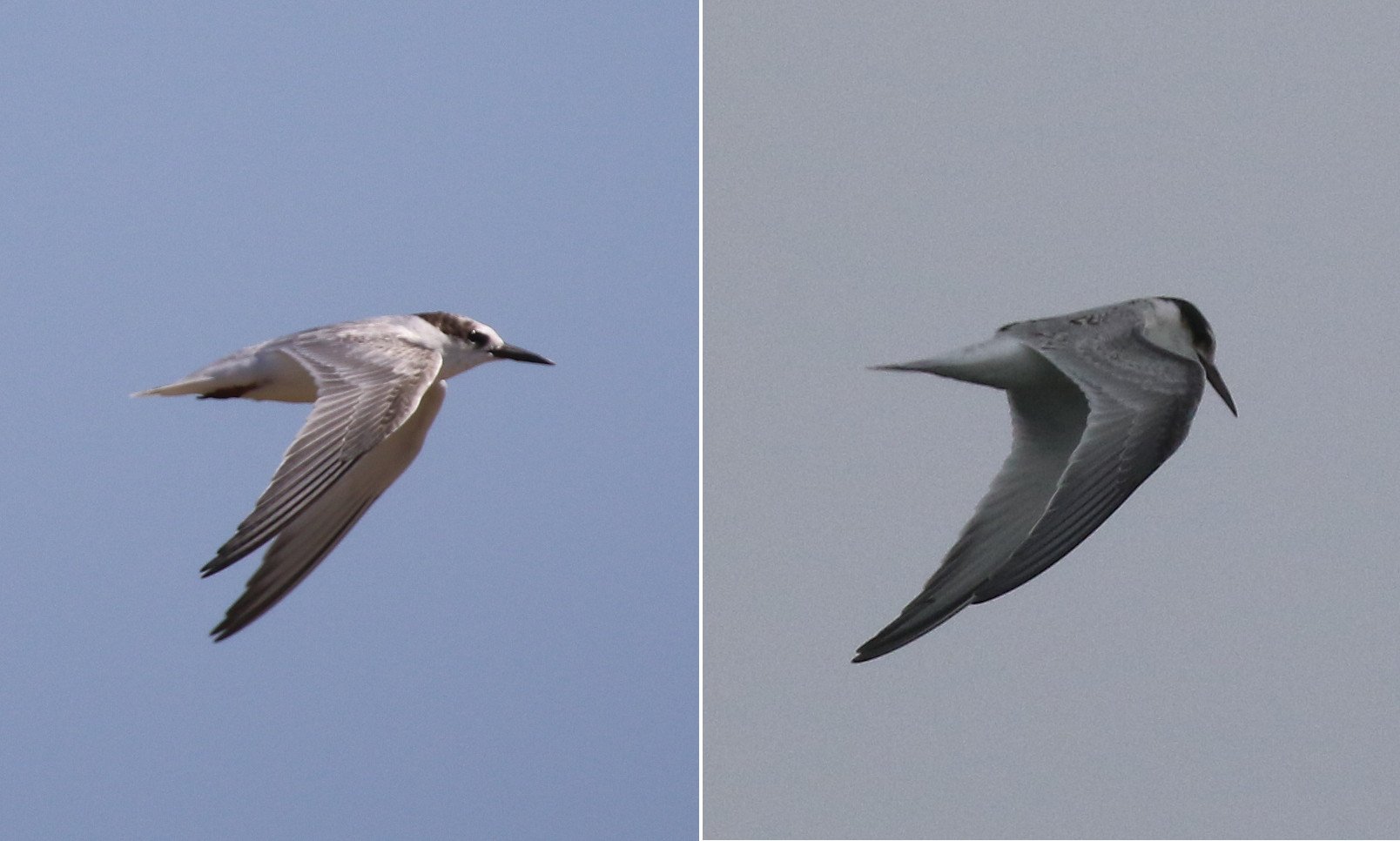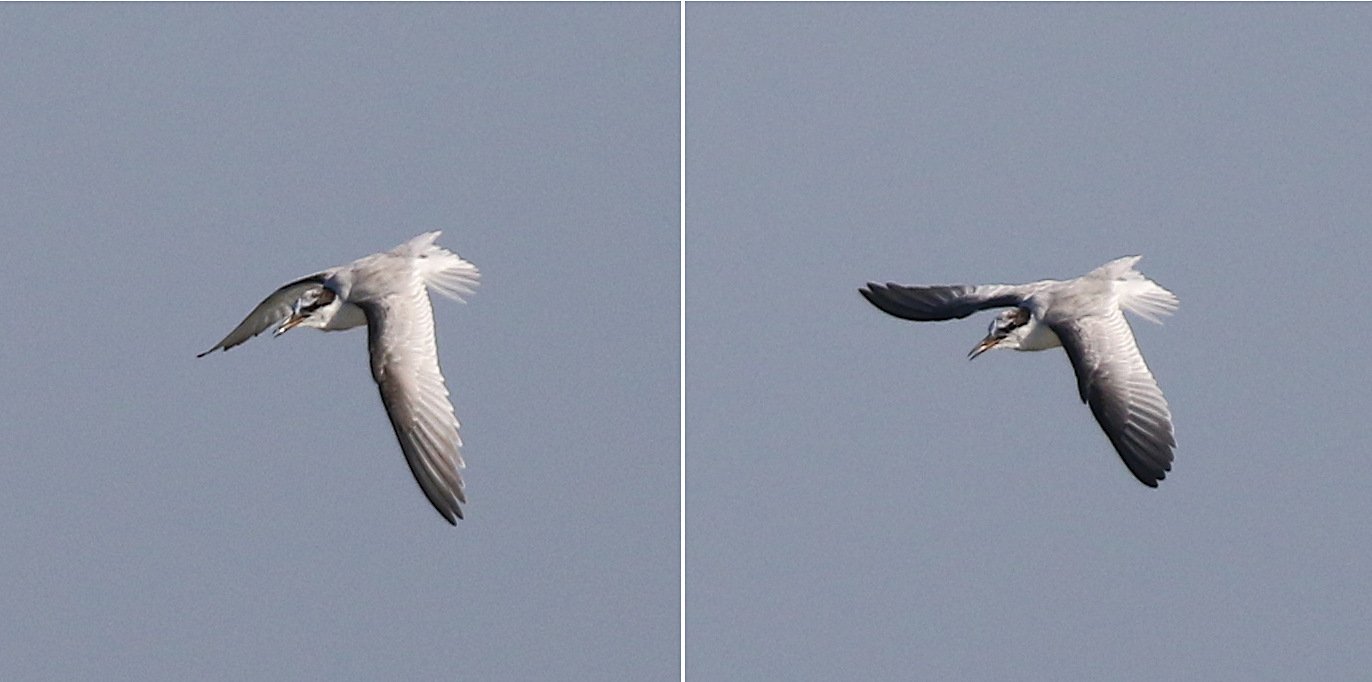Separation of 1cy Little and Least Terns and the first Least Tern for Spain
Least Tern is an extremely rare bird in the Western Palearctic, with only two birds identified to date (in the UK (1983-1992) and Ireland (2021)). Both birds were adults found within Little Tern colonies, and the identification was based, at least to some extend, on the distinct calls that these loud birds produce during the breeding season. Although there is a number of plumage and structural differences between Least and Little Terns in adult plumage (including shape of the white forehead patch, rump color, bill pattern, and size), they are all subtle and the general belief is that the identification of this species-pair (along with Saunders’ Tern, of course) is one of the thorniest challenges in seabird identification in Europe. The identification in juvenile/first-winter plumages is usually considered even more difficult or impossible in the field, although some differences - such as the head pattern - have been described in the literature (Chaendler & Wilds (1994), and well illustrated in Hans Larsson’s plates in Harrison (2021)).
Surprisingly, if one takes a closer look at the juvenile plumage of both species, a quick check is enough to realize that they are strikingly different: juvenile Least Tern always exhibits a characteristic upperwing pattern - reminiscent of that of Sabine’s Gull, actually - and diverging from the much more uniform upperwing of Little Tern. This pattern is definitely diagnostic and most/all birds may be identified with certainty upon it. Given that American terns usually show up in Europe as adult birds, one could argue that these young birds will not make their way to the European coast in fall, and only first summer or adult birds should be expected at this side of the pond. To prove this argument is wrong, I will discuss the identity of a first-winter bird seen in N Spain in September 2019 which in my opinion can be confidently identified as Least Tern.
Disclaimer: both Least and Little Terns present an extensive geographic variation; for instance, the Interior (ssp athalassos) and Western (ssp browni) populations of Least Tern often show greyer inner primaries and secondaries than birds from the Atlantic (ssp antillarum). On the other hand, Little Terns from Southern Asia (ssp sinensis) are closer in plumage to Least Tern than their European counterparts (ssp albifrons). Hence we will limit the discussion to the North Atlantic forms of both species (nominate antillarum from the US Atlantic seaboard and albifrons from Europe). My experience with Least Tern is mainly based on the study of birds breeding in Massachusetts.
Least Tern, juvenile, August 5th, Massachusetts, USA (Guillermo Rodríguez). To those familiar with juvenile Little Terns, the upperwing pattern of Least Tern is undoubtedly eye-catching: the inner white patch formed by the snowy white secondaries, greater coverts and inner primaries sharply contrasts with the uniform dark outer primaries and primary coverts. The inset shows a detail of the primary pattern, with the typical white tongues that are often seen in p5-p7 marked with red lines.
Diagnostic features to separate juvenile Little and Least Terns
There is a number of plumage features that differ in both species in juvenile plumage, but due to extensive individual and geographical variation only two can be considered as truly diagnostic:
Head pattern. The dark cap of Little Tern is more extensive and solid than in Least Tern, in which the crown is largely pale-tipped and patterned. The difference is generally not so obvious in fresh juvenile birds, but it becomes diagnostic later in the season as plumage wears and especially after the head is moulted: Little Tern retains a relatively dark head including the crown and extending towards the lower neck, whereas Least Tern becomes much white-headed as the dark disappears from the crown and they only show a solid black patch behind the eye, sometimes resembling a Forster’s Tern (although in other cases the nape remains black).
Upperwing pattern. Least Tern shows a contrasted upperwing, with dark outer primaries and very pale secondaries, presenting a similar pattern to, for instance, Sabine’s Gull. The wing is much less contrasted in Little, with paler outer primaries than Least and grey secondaries. There is little or no overlap between both patterns, making this a very useful character if seen well enough:
Least Tern: birds present very dark p4-p10 primaries, with uniformly dark p7-p10. p4-p6 invariably show contrasted white tongues on the inner webs that are often visible in the field, and the most patterned birds also show some dark on p3. p1-p3, the secondaries and at least the distal part of the greater coverts are purely white, forming an extensive white patch along the trailing edge of the wing. It seems that birds show more grey in the inner primaries as one moves south (eg birds from the Caribbean).
Little Tern: very uniform wing with neat grey secondaries, greater coverts and inner primaries, and only slightly darker outer 3 primaries. The outer primaries show a white edge along the inner web which is not usually visible in the field, but p3-p6 never show an obvious (broad and contrasted) tongue as in Least.
Both the head and the upperwing patterns differ enough between Least and Little Terns to be considered diagnostic, but I find that the upperwing pattern is less variable, and it is therefore a more reliable feature.
Least Terns, juvenile, July/August, Massachusetts, USA (Guillermo Rodríguez). A few examples of juvenile Least Terns in fresh plumage. Least Terns typically look paler and greyer than Little; the crown is sparsely spotted and only the eye-mask looks solid dark. The primaries are uniformly dark, strongly contrasting with the mantle. The white greater coverts can be noticed even when perched.
Little Tern, mostly juvenile, September 6th, Andalucia, Spain (Andres Rojas). A Little Tern for comparison showing all the typical features, including extensive head cap, pale grey primaries barely contrasting with the upperwing/mantle, and grey greater coverts. Note the distinct shape of the two moulted scapulars.
Least Tern, juvenile, August 13th, Massachusetts, USA (Guillermo Rodríguez). Note the uniform primary coverts and how obvious and well-contrasted the white tongues look in most pictures.
Least Tern, juvenile, July 22th, Massachusetts, USA (Guillermo Rodríguez). The upperwing pattern of birds breeding in the Atlantic coast of the US exhibits reduced variation, but birds from the Caribbean or California can show slightly greyer inner primaries.
Little Terns, juveniles, July 15th, Valencia, Spain (Yanina Maggiotto). Two fresh juvenile Little Terns for comparison. The upperwing looks mostly uniform as a result of both paler outer primaries and greyer inner wing than in Least. Note how the inner pale fringes of the primaries are never visible in the field. The rump is slightly paler than in Least but this feature is highly variable in juveniles and thus of little use.
The transition to first-winter plumage (Sept-Oct)
The effect of wear is a key aspect to be considered when identifying terns, since the flight feathers turn increasingly dark as they wear off. It is thus important to study how juvenile birds look in late September-October, arguably the most likely period to find a juvenile Least Tern in Europe. Both species start moulting body feathers before migration (typically a few scattered scapulars or the entire back, depending on the departing date), but the replacement of the flight feathers does not start until they reach the wintering quarters. Once they leave the breeding grounds, both Little and Least Terns become quite pelagic and there are not many pictures of these species as migrants; Least Terns in particular seem to disappear in the Caribbean!
Least Tern
The few pictures of migrant juvenile Least Terns off the East Coast of the US I have managed to study show even more contrasted birds than when fresh, with a dark and broad band along the leading edge of the wing contrasting with a purely white inner wing. The diagnostic primary pattern remains defined enough to be used as an identification feature. Once the primary moult starts in late fall, the second generation feathers are light grey and thus similar to that of Little; second-generation secondaries and greater coverts, on the contrary, remain remarkably white. During this period, the head pattern is truly distinctive: most birds show a very narrow mask, starting in front of the eye and extending towards the nape; in some birds the black does not reach the nape and it forms and isolated patch behind the eye, resembling a Foster’s Tern (I’m not sure whether this appearance is acquired through wear of the dark feather tips or it is the new pattern of the 1w plumage, or if both processes lead to the same pattern). Below some examples of worn 1cy Least Tern are depicted – these are local birds from Aruba, but they may help to get a sense about what to expect in a vagrant Least Tern in September in Europe.
Least Tern, first-winter, August 20th, Aruba (Michiel Oversteegen). This bird has moulted all the scapulars and mantle (and likely the head too) but retains a completely juvenile wing. Note how the entire leading edge of the wing turns dark as the juvenile feathers wear, strongly contrasting with the white greater coverts. The facial mask is narrow, leading to an entire white crown and lower neck.
Least Terns, first-winters, September 30th, Aruba (Michiel Oversteegen). Two examples of how first-winter birds look in early fall. The overall looking is quite striking due to the combination of reduced black on the head, white inner wing and contrasting dark leading edge of the wing and outer primaries.
Least Tern, first-winter, October 22th, Aruba (Michiel Oversteegen). One more example of first-winter Least Tern, showing how the primary pattern remains in good condition by early fall, including the characteristic white tongues in p5 and p6.
Little Tern
Little Terns migrate off the Atlantic coast of the Iberian Peninsula from mid-September to early October on their way to their wintering grounds in the Gulf of Guinea; these migratory birds surely originate from the breeding colonies in the North Sea and Baltic. By early autumn, these northern breeders still retain a largely juvenile aspect, exhibiting a fresh plumage and with only a few replaced scapulars. As an effect of wear, the primaries look a bit darker than in juveniles, especially the three outer ones - although not as neat dark and uniform as in Least, as worn primaries look a bit ‘dirty‘. Typically there is a gradient in darkness from the still pale grey inner primaries to the dark outer ones. The rest of the wing remains noticeable grey, including secondaries and greater coverts.
Little Tern presents a broad latitudinal range, and the general appearance of northern and southern breeders is indeed quite different. The birds from the Southern Mediterranean look much more worn and advanced in moult in August than the northern breeders do in September. When facing such a worn bird it is important to study the plumage in detail, since in poor photographs or under strong light conditions feathers often look darker than what they truly are. But, if seen well enough, the greyish secondaries and the smooth outwards darkening across the primaries should be always noticeable.
Little Tern, first-winter, October 4th, Galicia, Spain (Alvaro F. Polo). A typical migrant Little Tern seen in northern Spain (where the species does not breed). In September the primaries are a bit worn, looking darker than when fresh; note the typical gradient in darkness from the inner ones to the outest one. This bird shows reduced dark in the head, but still there is some sparse streaking on the crown and the black extends down towards the lower neck.
Upperwing pattern in juvenile Little Terns: pictures in hand to understand the primary pattern in deeper detail. From up to bottom: Falsterbo, Sweden, September 3rd (Stephen Menzie).
Andalucia, Spain, August 13nd (Alberto Álvarez).
Andalucia, Spain, August 8nd (Alberto Álvarez).
Pictures in hand allow to understand further the real pattern of the primaries. Most Little Terns show a white fringe in the inner web of the outer primaries, although usually not very contrasted. These fringes are rarely seen in the field because typically the dark band is broader than the white band, and thus the white remains hidden. In p5-p7 the white band can be broad in some birds but usually not forming a square-shaped “tongue“ as in Least.
Note also the typical gradient in darkness along the primaries, with the inner ones looking quite pale in some birds/light conditions. The secondaries show broad white fringes but the centre of the feather is always grey.
Little Terns, first-winters, September 20th, Galicia, N Spain (Alvaro F. Polo). Two more examples of Little Terns from N Europe, photographed in one of their stopover sites in N Spain. Most birds remain largely juvenile; note solid dark cap and uniform grey upperwing in both birds.
Little Tern, first-winters: (left) August 14th, Andalucia, S Spain; and (right) September 25th, Cantabria, N Spain (Guillermo Rodríguez). Comparison between a southern breeder seen in August and a northern breeder seen in late September. Southern birds usually look quite worn and advanced in moult, although the characteristic features of the species (extension of cap, uniform wing, grey secondaries) are all still visible.
Summary of key features
When facing a 1cy bird in Europe, the main features that may point towards Least Tern are:
Large, purely white wing panel that includes secondaries, most greater covers and inner primaries. Always grey in Little, but sometimes difficult to notice under strong light.
Dark, homogeneous outer 6 primaries, often showing contrasted and deep white tongues in p5-p7. Usually showing a gradient in darkness in Little - with at most the outer three being truly dark when worn - and lacking obvious white tongues.
Reduced black cap, either forming an isolated patch behing the eye or reaching the nape but never extending above the eye. Solid dark cap extending towards the crown and down to the lower neck in most Little Terns in September.
Little Tern, first-winter, August 14th, Andalucia, S Spain (Guillermo Rodríguez). An example of how light artifacts can be misleading with worn birds in poor pictures. Both pictures were taken within a few millisecond window; note in the left shot only 2-3 primaries look truly dark and the gradient along the primaries is obvious , whereas in the right picture at least 6 primaries look “dark enough for Least” and the wing shows a high contrast. Only trust pictures in which the real pattern of the feathers can be confidently addressed!
The first Least Tern for Spain
On September 26, 2019, Itziar Gutierrez and Martín Larrañaga located an interesting ‘Little Tern’ in Gipuzkoa, Basque Country, N Spain. They immediately identified it as a potential candidate for Least Tern, and posted it on eBird along with the following description: “Possible 1st winter Least Tern. The bird shows a reduced black mask with a v-shape in the nape. It also shows a dark patch in the carpal area that extends along the entire wing” (translated from spanish). Itziar took a number of pictures that clearly show all the diagnostic features of a juvenile Least Tern, including
A reduced dark patch behind the eye, quite narrow and nearly broken at the nape, with a neat white crown and neck.
Uniform dark outer 6 primaries, grey shadow in p4 combined with contrasted white inner tongues in p5-p7. The neat shape of the tongues suggests that the primaries are not very worn.
White p1-p3, secondaries and greater coverts. The apparent good state of the primaries suggests that the wing is not particularly worn/abraded, and thus this snowy feathers represent the real plumage pattern.
Least Tern, first-winter, September 26th, 2019, Basque Country, N Spain (Itziar Gutiérrez). These amazing set of pictures show what in my opinion can be identified as Least Tern with confidence. Among with other features, note: (1) reduced mask, white crown; (2) dark uniform primaries contrasting with the wing coverts; and (3) dark leading edge of the wing contrasting with white secondaries and greater coverts.
Least Tern, first-winter, September 26th, 2019, Basque Country, N Spain (Itziar Gutiérrez). This picture of the spread wing shows well the primary pattern, the real clincher to address the true identity of the bird. The secondaries and greater coverts are snowy white; the outer 6 primaries are uniformly dark , and showhing deep white tongues on p5-p7.
As Itziar and Martin suspected, I’m certain that this bird can be identified as Least Tern without doubt. This amazing record still needs to be studied by the Spanish Rarities Committee but hopefully it will be accepted, representing the first Least Tern for Spain and the first 1cy bird found in Europe.
This Least Tern was found after a remarkable event of westerly winds that surely drifted the bird towards the corner of the Bay of Biscay. The previous day, several Madeiran Storm Petrels and a South Polar Skua were seen close to shore in Galicia (N Spain) - including a Madeiran that was found exhausted in a small village. Also of note was a Fea’s Petrel seen in Asturias (where the species is very rare as it is much further inside the Bay of Biscay than Estaca de Bares, where Fea’s Petrel is regularly seen in September). All these records suggest that strong winds from the central Atlantic were pushing many seabirds towards the European coast.
Acknowledgements
I would like to thank Itziar Gutierrez for allowing me to share her pictures and sighting here. All the photographers kindly allowed me post their pictures here; Alberto Álvarez, Yosef Kiat and Ulf M. Berthelsen sent me many pictures of juvenile Little Terns in hand for study. Michiel Oversteegen shared with me his extensive gallery of Least Tern from Aruba. Daniel L. Velasco and Killian Mullarney provided insights and interesting discussion about the id of Least Tern.
